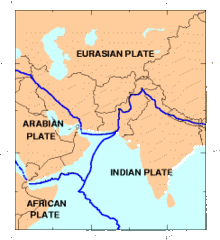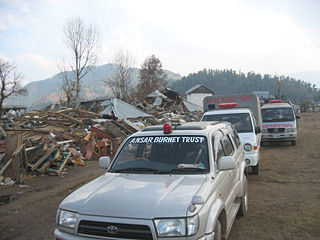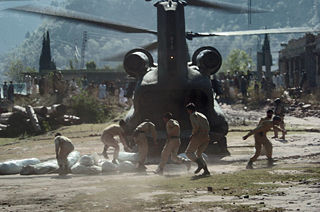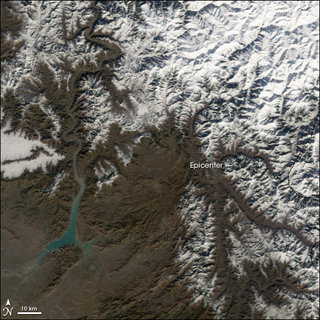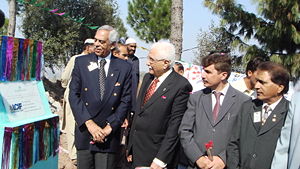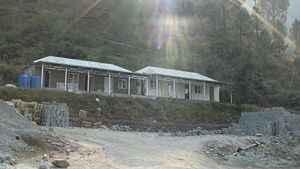2005 Kashmir earthquake
2008/9 Schools Wikipedia Selection. Related subjects: Natural Disasters
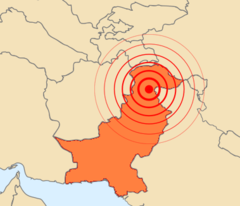 |
|
| Date | October 8, 2005 |
|---|---|
| Magnitude | 7.6 Moment magnitude scale |
| Depth: | 10km |
| Epicenter location: | Muzaffarabad, AJK |
| Countries/ regions affected |
|
| Casualties: | 74,500+ dead ( 14th deadliest earthquake of all time) 106,000+ injured |
The 2005 Kashmir Earthquake (also known as the South Asian earthquake or the Great Pakistan earthquake) was a major earthquake centred in Pakistan-administered Kashmir (AJK) and in North West Frontier Province (NWFP). It occurred at 08:50:38 Pakistan Standard Time (03:50:37 UTC) on 8 October 2005. It registered a debatable 7.6 or 7.7 on the Richter scale making it similar in intensity to the 1906 San Francisco earthquake, 1935 Quetta earthquake, and the 2001 Gujarat earthquake. As of 8 November, the government of Pakistan's official death toll was 79,000, while officials say nearly 1,400 people also died in Indian-administered Jammu and Kashmir and four people in Afghanistan. The severity of the damage caused by the quake is attributed to severe upthrust, coupled with poor construction.
Human impact
Most of the affected people lived in mountainous regions with access impeded by landslides that blocked the roads, leaving an estimated 3.3 million homeless in Pakistan. The UN reported that 8 million people were directly affected, prior to the commencement of winter snowfall in the Himalayan region. It is estimated that damages incurred are well over US$ 5 billion (300 billion Pakistani rupees) Five crossing points were opened on the Line of Control (LoC) between India and Pakistan to facilitate the flow of humanitarian and medical aid to the affected region, and international aid teams from around the world came to the region to assist in relief.
The earthquake
Azad Kashmir lies in the area of collision of the Eurasian and Indian tectonic plates. . The geological activity born out of this collision, also responsible for the birth of the Himalayan mountain range, is the cause of unstable seismicity in the region. The United States Geological Survey (USGS) measured its magnitude as a minimum of 7.6 on the moment magnitude scale, with its epicentre at , about 19 km (11.8 miles) northeast of Muzaffarabad, Azad Kashmir, and 100 km (65 miles) north-northeast of the national capital Islamabad. The earthquake is classified as "major" by the USGS. The hypocenter was located at a depth of 26 km (16.2 miles) below the surface . The Japan Meteorological Agency estimated its magnitude at a minimum of 7.8. By comparison, the 2004 Indian Ocean earthquake had a magnitude of 9.15. The earthquake caused widespread destruction in northern Pakistan, as well as damage in Afghanistan and northern India. The worst hit areas were Azad Kashmir, Pakistan's North-West Frontier Province (NWFP), western and southern parts of the Kashmir valley. It also affected some parts of the Pakistani province of Punjab, the capital city of Islamabad, and the city of Karachi experienced a minor aftershock of magnitude 4.6. There have been many secondary earthquakes in the region, mainly to the northwest of the original epicentre. A total of 147 aftershocks were registered in the first day after the initial quake, of which one had a magnitude of 6.2 Twenty-eight of these aftershocks occurred with magnitudes greater. On October 19, a series of strong aftershocks, one with a magnitude of 5.8, occurred about 65 km (40.5 miles) north-northwest of Muzaffarabad. There have been more than 978 aftershocks with a magnitude of 4.0 and above, as of 27 October 2005 that continue to occur daily. (See USGS for a list of recent aftershocks and effects.)
Casualties
| 2005 Kashmir earthquake casualties | |||
| Location | Dead | Injured | |
| NWFP & Azad Kashmir, Pakistan | 73,338 | 100,000 | |
| Jammu & Kashmir, India | 1,360 | 6,266 | |
| Afghanistan | 4 | 14 | |
| Total | 74,500+ | 106,000+ | |
Most of the casualties resulting from the earthquake were in Pakistan administered Kashmir where the official confirmed death toll is 74,698, putting it higher than the massive scale of destruction of the 1935 Quetta earthquake. Nearly 1,400 people died in Indian-administered Kashmir, according to officials. International donors have estimated that about 86,000 died but this has not been confirmed or endorsed by Pakistani authorities.
As Saturday is a normal school day in the region, most students were at schools when the earthquake struck. Many were buried under collapsed school buildings. Many people were also trapped in their homes and, because it was the month of Ramadan, most people were taking a nap after their pre-dawn meal and did not have time to escape during the earthquake. Reports indicate that entire towns and villages were completely wiped out in Northern Pakistan with other surrounding areas also suffering severe damage.
- "...a second, massive wave of death will happen if we do not step up our efforts now", Kofi Annan said on 20 October with reference to the thousand remote villages in which people are in need of medical attention, food, clean water and shelter and the 120,000 survivors that have not yet been reached."
According to Pakistan's Interior Minister Aftab Sherpao, Prime Minister Shaukat Aziz
- "made the appeal to survivors" on 26 October to come down to valleys and cities for relief, because bad weather, mountainous terrain, landslides and blocked roads are making it difficult for relief workers to reach each house and the winter snows are imminent."
Damage
Jammu and Kashmir
- 1,500 houses were destroyed in Uri. About 90% of the families living in the town, which has a population of 30,000, were affected by the quake. *More than 1,100 houses were flattened in Indian Kashmir. The main minaret of the Hazratbal shrine, which is believed to house a relic of the prophet Muhammad was damaged.
- The 200-year-old Moti Mahal fort in Poonch district, Kashmir, collapsed.
- Buildings in Delhi and Amritsar were damaged, and tremors caused panic in Gujarat.
- The tremors were also felt in Uttar Pradesh, Uttaranchal, Himachal Pradesh, Rajasthan, and Madhya Pradesh.
- There were over 1300 dead.
Afghan Territory
Four deaths were reported in Afghanistan, including a young girl who died in Jalalabad after a wall collapsed on her. The quake was felt in Kabul, but the effects were minimal.
Rescue and relief operations
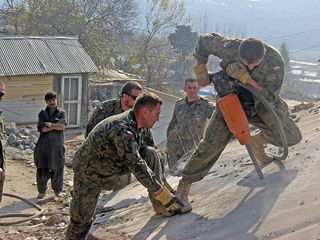
Relief efforts in many remote villages were loaded, as roads were buried in rubble and many affected areas remained inaccessible. Heavy equipment was needed to clear the roads and to rescue survivors buried under the earthquake wreckage, as many rescuers were picking the rubble with pickaxes and their bare hands, looking for survivors.
Rescue efforts were also affected by the numerous aftershocks that continued to rattle the region and put rescue workers in danger as they searched through the wreckage for survivors. Five crossing points were opened on the Line of Control (LoC) between India and Pakistan in the province of Kashmir. The first was opened at Chakan Da Bagh in Poonch, the second at Kaman Post in Uri (on the road between Srinagar and Muzaffarabad) and the third across the Neelum river between Chiliana in Pakistan and Tithwal in India. These facilitated the flow of relief goods and allowed people to meet relatives across the Line of Control.
In many areas there was no power, or adequate food or water; there was also the danger of disease spreading , including measles. Distributing relief supplies to the victims was especially urgent as the victims face the risk of exposure to cold weather due to the region's high altitude and the approaching winter. Food, medicine supplies, tents and blankets were identified by relief workers as essential items. On October 10, the United Nations warned that the earthquake left 2.5 million people homeless and they were in need of shelter. The UN made an appeal to raise US$272 million to help victims.
On October 13, snow started to fall on the Indian side of Kashmir. Many regions are facing an increasing threat of being cut off from help as snow forces closures of even more roads in the mountainous region.
Pakistan
In Northern Pakistan and Pakistan-administered Kashmir, the Pakistan Army has been directed to ask the concerned authorities to carry out an immediate assessment of the extent of damage caused by it. The Government of Pakistan opened President's Relief Fund for Earthquake relief operation, where donations can be made and also appealed for International Aid as the magnitude of the disaster becomes clear. Earthquake relief blankets, tents, medicine, warm clothes, food and many more supplies are needed. Pakistan International Airlines (PIA) has offered free delivery of goods from anywhere in the world to Pakistan. Turkey has offered to airlift relief goods that arrive in Turkey to Pakistan free of cost. Pakistani Prime Minister Shaukat Aziz spoke on the telephone with authorities in four provinces plus Azad Kashmir, and directed them to utilize all machinery and make all possible efforts to help the victims. He said the entire federal administration, civil and military authorities have been alerted, and relief goods have been provided to them for the victims of the quake. Most of the roads are closed in the Northern Sector near the earthquake, and some have been completely washed out or blocked by landslides, so the Pakistani army is flying supplies in by helicopter. In Garhi Habibullah, a town 205 miles (328 km) from the devastated city of Balakot in north-west Pakistan, a few Kashmiri fighters known as the mujahideen put aside their weapons and spent two days in helping rescue dozens of girls who were trapped in a collapsed building of a girls' school. However, some militant groups operating in Kashmir continued to attack and kill Indian soldiers in the Indian state of Jammu and Kashmir to prove that despite reports by India that claimed that terrorist training camps in Pakistan were destroyed, the militant network was still alive. Soon after the earthquake struck, NGO's started their relief efforts.
On October 10, Monday, survivors were still being found and rescued from the wreckage including a 2-year-old girl in Islamabad. Then on Wednesday, a Russian rescue team rescued a 5-year-old girl in Muzaffarabad who has been trapped for nearly 100 hours. On October 14 the Pakistan government agreed that unaccompanied children from the disaster should be taken to the SOS Children emergency shelter in Islamabad for family tracing in a central database and help and created a credit programme for affected families. They also agreed that SOS should be temporary guardian until relatives were traced. The Pakistani people from all regions and walks of life donated a huge amount of relief supplies in both goods and money for the earthquake victims which is unprecedented in the history of nations. The magnitude of this disaster was so vast that the Government alone could not provide relief to the people affected by this earthquake. The response of the people of Pakistan to help the government in its relief efforts was overwhelming in the shape of donations, relief goods and volunteers working in the hospitals and the earthquake hit areas.
On October 10th, NATO received a request from Pakistan for assistance in dealing with the disaster. The next day, the North Atlantic Council (NAC) approved a major air operation and NATO used its Airborne Early Warning and Control Force Trainer Cargo Aircraft (TCA) to establish an air bridge to transport donated supplies from NATO and Partner countries to Pakistan . On October 14th, the first NATO aircraft arrived in Islamabad with seven tons of donated tents, blankets and sleeping bags from Slovenia . Two days later the first NATO chartered AN-124 aircraft landed in Pakistan with 45 tons of donated relief items. Virgin Atlantic also operated a special relief flight to Islamabad using a Boeing 747 with 55 tonnes of aid.
NATO Secretary-General Jaap de Hoop Scheffer declared on NATO's role in humanitarian assistance; "NATO is not, and does not aspire to be, a humanitarian organisation. But we are glad that, in the face of this terrible disaster, we were able to deliver emergency relief, our doctors could treat patients and our engineers could help begin the process of reconstruction."
Five days later, NATO established a second air bridge from Incirlik, Turkey, to Islamabad using NATO Response Force (NRF) tactical aircraft to carry supplies (blankets, stoves, tents) donated by the UNHCR. The air bridge also operated from Ramstein Air Base in Germany. Offers from NATO and partner nations were coordinated by NATO’s Euro-Atlantic Disaster Response Coordination Centre (EADRCC), working in conjunction with the UN Office for the Coordination of Humanitarian Affairs (OCHA), the EU, and the Government of Pakistan.
Meanwhile, NATO planners at SHAPE rapidly prepared options for NATO land forces to help in the earthquake zone itself and on October 21st, the NAC approved the sending of engineer, medical and helicopter units. The NRF Deployable Joint Task Force (DJTF) HQ was deployed to Islamabad on October 24th. Its task: to pave the way for the arrival of the forces and to co-ordinate with Pakistani authorities. The Spanish-led Land Component Command of the NRF controlled operations in the earthquake zone.
The advance elements of a Dutch medical team arrived on October 29th and moved to the Bagh area, where they immediately began treating hundreds of people a day. On November 9th, the team opened a field hospital and went on to set up mobile medical units in the Bagh area once they were reinforced by British, Czech and French medical personnel.
NATO engineering teams from Italy, Poland, Spain and the United Kingdom, supporting Pakistani efforts to repair roads and build shelters and medical facilities, joined the Canadian Disaster Assistance Relief Team (DART) and a Lithuanian water purification team, already working in the vicinity of Bagh.
NATO helicopters, among them four German CH-53 heavy-lift transport helicopters, and a Luxembourg Air Rescue helicopter, flew relief goods daily to remote mountain villages and evacuated victims before the winter set in.
During the NATO Disaster Relief Mission some 1,000 engineers and supporting staff, as well as 200 medical personnel, worked in Pakistan . The mission for NATO officially came to an end on February 1st, 2006 .
NATO's Role in Pakistan did not meet with unanimous approval. Some Pakistani political parties have criticized President Pervez Musharraf's government for inviting NATO troops to take part in the relief and reconstruction efforts in Kashmir without the approval of parliament. Most of this criticism came from Musharrafs' opponents, opposed to his pro-western and pro-American stance, who sought for a reason to criticize the president in public. Some legitimate concerns were expressed about the potentiality of NATO trying to set up a permanent presence in the region with an eye towards Afghanistan. NATO quickly capatalized on its humanitarian role and promised not to set up a permanent presence. Vice Admiral John Stufflebeem commander of the response force on NATO relief operations for the earthquake responded to questions "This is only humanitarian assistance. We are responding to where we are asked to go and for that we rely on Pakistan to determine. We are here not to do anything other than try to help and we will stay only as long as our host will have us."
In the midst of the disaster, Focus Humanitarian Assistance (FOCUS), an agency affiliated with the Aga Khan Development Network (AKDN) responded by mobilising specialised staff, volunteers and resources. FOCUS conducted search and rescue operations and distributed essential relief items to tens of thousands of families in the affected areas of Islamabad, Muzaffarabad and other remote regions of the country. To assist in the operations, FOCUS was able to bring in four AKDN helicopters which made numerous trips into the affected area, carrying relief items including staple foods such as oil, lentils and rice, as well as tents, blankets and medical supplies which were distributed to thousands in need. On their return journeys to Islamabad, the helicopters, along with numerous US military helocopters, carried survivors requiring urgent medical assistance. In recognition of their rescue and relief efforts, FOCUS received the Sitara-e-Eisaar, conferred by President of Pakistan, General Pervez Musharraf on June 30, 2006. A large number of American, European, and Asian nonprofits also entered the region and mounted a massive relief operation that in some areas is still ongoing today.
In late 2006, a staggering $20 billion development scheme was mooted by Pakistan for reconstruction of the earth-quake hit zones in Azad Kashmir. A land use plan for Muzaffarabad city had been prepared by Japan International Cooperation Agency.
Pakistan established the Earthquake Reconstruction & Rehabilitation Authority to rebuild the area.
India
- In the Indian-administered Jammu and Kashmir, the injured are being treated at Srinagar's SMHS hospital and the Uri Field Hospital, with many makeshift medical facilities being set up to help the injured. Hundreds of people have been brought in, many of them critically injured. In keeping with a traditional duty since independence, the Indian Army has undertaken a key role in coordinating and running relief operations.
- Indian Prime Minister Manmohan Singh, and Leader of the Opposition L.K. Advani visited quake-hit areas An ex gratia of Rs one lakh (100,000 Indian rupees, about US$2255) to the next of kin of those killed in the quake was being released from the Prime Minister's National Relief Fund.
International response
Many countries, international organizations and non-governmental organizations have offered relief aid to the region, in the form of donation as well as relief supplies including food, medical supplies, tents and blankets.
Rescue and relief workers were sent to the region from different parts of the world and they brought along rescue equipment, including helicopters and rescue dogs.
The United Nations has appealed for donations to raise at least US$272 million to help victims of the quake.
The International Association of Lions Clubs (LCI) & Lions Clubs International Foundation (LCIF) donated an amount of US$ 892,000/- for the reconstruction of 150 houses along with supporting infrastructure and a water supply system at Village Anwar Sharif, Muzaffarabad, Azad Kashmir.
The project was completed in July 2007 and the houses were handed over to their occupants by the International Director of Lions Clubs International, Lion Malik Khuda Baksh on July 26, 2007. Mr. Raja Zulqarnain Khan, President of the Azad Kashmir was the Chief Guest of the Ceremony.
A team of volunteer New York City paramedics travelled to the remote villages of Kashmir two weeks after the earthquake and treated over 200 patients a day in a two week relief effort.
Many international relief organizations remain, particularly in the hard hit areas of NWFP and rural Kashmir .
